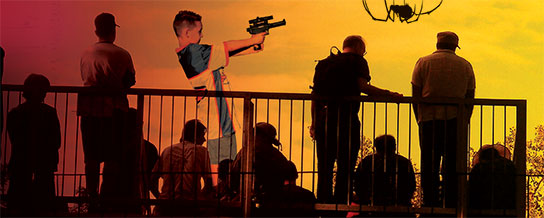What Is It? Powerviolence
By the late ’80s, hardcore punk’s “loud, hard, fast” rigidity had alienated many of the […]

What Is It? Powerviolence
By the late ’80s, hardcore punk’s “loud, hard, fast” rigidity had alienated many of the […]

By the late ’80s, hardcore punk’s “loud, hard, fast” rigidity had alienated many of the scene’s originals. Bands like Black Flag and D.R.I. went metal-sludge; Ian MacKaye shifted to a melodic attack with Fugazi. But not everyone ditched the original sonic ideals, as exemplified by powerviolence, a punk offshoot that sprung up in California around that time. Characterized by alternating sludge ’n’ blur tempos, roaring vocals, and sub-30-second songs, powerviolence took the “hardcore” from hardcore punk and amplified it to occasionally cartoonish extremes.
The name “powerviolence” was coined in 1989 during a heated musical debate between Eric Wood and Matt Domino, then members of the band Neanderthal. Domino blurted out “fuckin’ powerviolence,” and the name later morphed into the location-centric boast “West Coast powerviolence.”
“The peak of West Coast powerviolence hit around the mid-’90s,” explains Chris Dodge, both founder of the scene’s homebase label, Slap a Ham Records, and singer and bassist in Spazz. “At the time, punk clubs in the Bay Area were catering to bands like Green Day and really crappy ska-core… Extreme, thrashy hardcore music just wasn’t ‘cool.’ So I felt like I needed to intervene.”
Through Slap a Ham, Dodge helped introduce hardcore fans to an entirely new aesthetic–one that challenged the definitions of punk. Releases like Man Is the Bastard’s D.I.Y.C.D. subverted typical instrumentation, using a combination of bass-guitar attack with jazz/prog tendencies and experimental noise. M.I.T.B. included Neanderthal alum Wood on vocals and DIY electronics master Henry Barnes, who would later form the folk-noise project Amps for Christ. “[M.I.T.B.] was the most unique band of their day,” says Dodge. “Their philosophies (not the least of which is in their name) embody the sensibilities of the scene more than anyone.”
Other crucial releases on Slap a Ham included No Comment’s 1992 7-inch “Downsided,” a definitive document of powerviolence’s beyond-tantrum aggression. “Crossed Out, Neanderthal, M.I.T.B. … All the best stuff came out on Slap a Ham,” says Jensen Ward, drummer for Seattle neo-powerviolence band Iron Lung. “I don’t know where I would be without Chris Dodge.”
Neo-powerviolence bands like Iron Lung, who carry the torch for genre’s ideals, are proof of powerviolence’s lasting impression. Borrowing from the noise experimentation of the mid-’90s, bands flying the genre’s banner have even fewer rules than before. “We get hardcore kids, metalheads, artists, noise fans, and even moms who know nothing about punk,” says Ward. “We’ve always gotten a mixed crowd… anyone that feeds off real, intense energy.”

